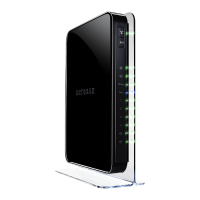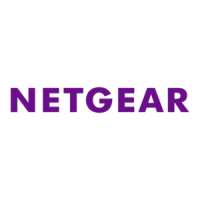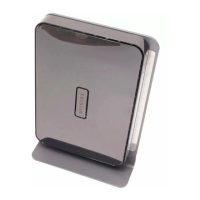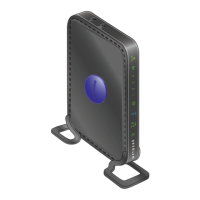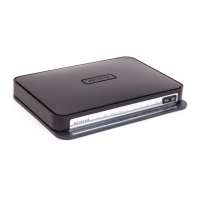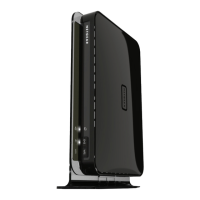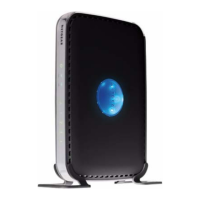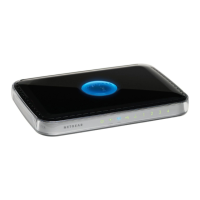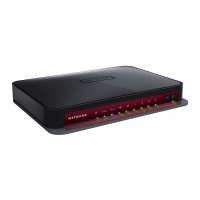Do you have a question about the NETGEAR WNDR4500v2 and is the answer not in the manual?
Instructions for unpacking the router and checking the package contents.
Guidance on the best placement for the router to ensure optimal wireless signal.
Overview of the router's physical features, including front and back panels and LEDs.
Details necessary information and steps before beginning the router setup process.
Explains the different types of logins used for router and internet access.
Step-by-step guide to setting up the router using the NETGEAR genie software.
Instructions for accessing and using NETGEAR genie after the initial setup is complete.
Configuration steps for setting up the router's internet connection.
Information on viewing devices currently connected to the network.
Details on setting up parental controls to manage internet content.
Guidance on accessing and configuring connected USB storage devices.
Configuration options for basic wireless network settings like SSID and security.
Instructions for setting up a separate network for guest access.
Guide to using the setup wizard for initial router configuration.
Instructions for using the WPS wizard to easily connect wireless devices.
Information on the types of USB drives and their compatibility with the router.
How to access shared USB storage devices from network computers.
Information about using the router with TiVo for media playback.
Examples and use cases for sharing files via USB storage.
Configuration of basic settings for USB storage devices.
Advanced configuration options for USB storage access and features.
Procedure for safely disconnecting USB drives to prevent data loss.
Settings for configuring the router as a media server for DLNA/UPnP devices.
How to configure the router to share only specific approved USB devices.
Instructions for accessing USB drives remotely over the internet.
Enabling and using ReadySHARE Cloud for remote access to USB storage.
Information about using the router with macOS Time Machine for backups.
Steps to set up Time Machine for backing up to a USB drive connected to the router.
How to access the connected USB hard drive from a Mac using Time Machine.
Recommendations for ensuring successful large data backups with Time Machine.
How to change the partition scheme of a USB drive for router compatibility.
Guide to setting up and using a USB printer with the ReadySHARE feature.
Information about the NETGEAR USB Control Center utility for printer sharing.
How to block specific websites or content using keywords in HTTP traffic.
Configuring port filtering to block specific internet services or applications.
Setting schedules to block internet access or specific services at certain times.
Configuring email notifications for security events detected by the router.
Steps to update the router's firmware to the latest version.
How to view the current status and usage information of the router.
Accessing logs of internet activity and attempted access for security monitoring.
Options for backing up, restoring, or resetting router configuration settings.
Procedure for changing the router's administrative login password.
Setting up password recovery options for the administrative account.
Detailed configuration options for wireless network behavior and features.
Configuring the router to act as a wireless repeater to extend network coverage.
Enabling specific traffic to pass through the firewall for applications or servers.
Configuring rules to make local servers accessible from the Internet.
Setting up dynamic port opening based on outbound traffic.
Configuring dynamic DNS to access the network using a domain name.
Manually configuring static routes for specific network traffic paths.
Enabling and configuring remote access to manage the router over the Internet.
Advanced settings related to USB device sharing and access.
Enabling UPnP for automatic device discovery and network configuration.
Configuring IPv6 internet connection types.
Monitoring and setting limits for internet traffic volume.
General tips for troubleshooting common network and router issues.
Interpreting router LED indicators for troubleshooting.
Steps to resolve issues when unable to log in to the router interface.
Diagnosing and resolving problems preventing internet access.
Troubleshooting why router configuration changes are not being saved.
Steps to troubleshoot issues with wireless device connectivity.
How to reset the router to its factory default settings and password.
Using the ping utility to diagnose network connectivity problems.
An overview of the router's capabilities and initial setup context.
Details necessary information and steps before beginning the router setup process.
Explains the different types of logins used for router and internet access.
Step-by-step guide to setting up the router using the NETGEAR genie software.
Instructions for accessing and using NETGEAR genie after the initial setup is complete.
Overview of the router's home screen and its main sections for status monitoring.
Instructions for connecting wireless devices to the router.
Information about using the NETGEAR genie mobile application.
Configuration steps for setting up the router's internet connection.
Information on viewing devices currently connected to the network.
Details on setting up parental controls to manage internet content.
Guidance on accessing and configuring connected USB storage devices.
Configuration options for basic wireless network settings like SSID and security.
Instructions for setting up a separate network for guest access.
Guide to using the setup wizard for initial router configuration.
Instructions for using the WPS wizard to easily connect wireless devices.
Accessing various setup menus for router configuration.
Configuration for the Wide Area Network (WAN) or Internet connection.
Configuration for the Local Area Network (LAN) settings.
Configuring Quality of Service to prioritize network traffic.
Enabling DoS protection against denial of service attacks.
Setting up a DMZ server for specific applications like gaming or conferencing.
Configuring the router to respond to ping requests from the Internet.
Disabling IGMP proxying for multicast traffic control.
Adjusting the Maximum Transmission Unit size for optimal internet performance.
Configuring Network Address Translation filtering for security and application compatibility.
Setting the router's IP address for the local area network.
Configuring the subnet mask for the local area network.
Instructions for modifying the router's LAN configuration.
Configuration of IP address, subnet mask, and RIP settings.
Enabling the router to act as a DHCP server for network devices.
Assigning static IP addresses to specific devices on the network.
Step-by-step instructions for reserving an IP address for a network device.
Enabling WMM QoS to prioritize wireless multimedia traffic.
Configuring QoS policies to prioritize specific applications or devices.
Step-by-step guide to setting up QoS rules for applications and games.
Steps to configure QoS for traffic on a specific LAN port.
Steps to configure QoS for traffic from a specific MAC address.
Information on the types of USB drives and their compatibility with the router.
How to access shared USB storage devices from network computers.
Information about using the router with TiVo for media playback.
Examples and use cases for sharing files via USB storage.
Configuration of basic settings for USB storage devices.
Advanced configuration options for USB storage access and features.
Procedure for safely disconnecting USB drives to prevent data loss.
Settings for configuring the router as a media server for DLNA/UPnP devices.
How to configure the router to share only specific approved USB devices.
Instructions for accessing USB drives remotely over the internet.
Enabling and using ReadySHARE Cloud for remote access to USB storage.
Information about using the router with macOS Time Machine for backups.
Steps to set up Time Machine for backing up to a USB drive connected to the router.
How to access the connected USB hard drive from a Mac using Time Machine.
Recommendations for ensuring successful large data backups with Time Machine.
How to change the partition scheme of a USB drive for router compatibility.
Guide to setting up and using a USB printer with the ReadySHARE feature.
Information about the NETGEAR USB Control Center utility for printer sharing.
Steps to connect and share a USB printer using the ReadySHARE feature.
Configuring the USB Control Center utility settings.
Steps for connecting and using a USB printer with the utility.
How to block specific websites or content using keywords in HTTP traffic.
Configuring port filtering to block specific internet services or applications.
Setting schedules to block internet access or specific services at certain times.
Configuring email notifications for security events detected by the router.
Steps to remove keywords or domains from the blocking list.
Exempting a specific computer from website blocking and logging.
Steps to configure port filtering rules to block specific internet services.
Steps to configure schedules for blocking internet access or services.
Steps to configure email alerts for router security events.
Steps to update the router's firmware to the latest version.
How to view the current status and usage information of the router.
Accessing logs of internet activity and attempted access for security monitoring.
Options for backing up, restoring, or resetting router configuration settings.
Procedure for changing the router's administrative login password.
Details on the router's hardware and firmware versions.
Information about the router's LAN port status and MAC/IP addresses.
Information about the router's Internet port status and IP address.
Setting the wireless network name (SSID) for 2.4 GHz and 5 GHz bands.
Selecting the geographic region for wireless operation.
Choosing the wireless channel to optimize signal and reduce interference.
Selecting the wireless communication mode (e.g., 54 Mbps, 217 Mbps).
Enabling or disabling the wireless access point feature.
Controlling whether the wireless network name (SSID) is broadcast.
Preventing wireless clients from accessing each other or the network.
Configuring Wi-Fi Protected Setup for easy device connection.
Setting the guest network name (SSID).
Enabling or disabling the wireless access point for the guest network.
Controlling whether the guest network name (SSID) is broadcast.
Isolating guest network clients from the main network.
Granting guest access to the local network resources.
Information on when a log entry was recorded.
The IP address of the device initiating a logged event.
The destination address of the logged activity.
Whether the logged activity was blocked or allowed.
Saving the current router configuration settings to a file.
Loading previously saved router configuration settings.
Steps to configure security questions for password recovery.
Detailed configuration options for wireless network behavior and features.
Configuring the router to act as a wireless repeater to extend network coverage.
Enabling specific traffic to pass through the firewall for applications or servers.
Configuring rules to make local servers accessible from the Internet.
Setting up dynamic port opening based on outbound traffic.
Configuring dynamic DNS to access the network using a domain name.
Manually configuring static routes for specific network traffic paths.
Enabling and configuring remote access to manage the router over the Internet.
Advanced settings related to USB device sharing and access.
Enabling UPnP for automatic device discovery and network configuration.
Configuring IPv6 internet connection types.
Monitoring and setting limits for internet traffic volume.
Turning the router's wireless radio on or off.
Scheduling the wireless signal to turn off automatically at specific times.
Configuring WPS for easy connection of wireless devices.
Configuring the router to function as a wireless access point.
Restricting network access to specific devices via MAC address.
Setting up the router as a parent access point in a wireless repeating setup.
Activating the wireless repeating function for 2.4-GHz or 5-GHz networks.
Displaying the router's MAC address for reference in repeater setup.
Configuring the router to act as a wireless repeater.
Steps to configure the router as a wireless base station.
Understanding how the router handles communication sessions for remote access.
Recommendation to use reserved IP addresses for server stability.
Steps to configure Dynamic DNS for a changing IP address.
Steps to enable and configure remote access to the router's management interface.
Steps to configure an IPv6 internet connection.
Steps to enable and configure the traffic meter for monitoring internet usage.
General tips for troubleshooting common network and router issues.
Interpreting router LED indicators for troubleshooting.
Steps to resolve issues when unable to log in to the router interface.
Diagnosing and resolving problems preventing internet access.
Troubleshooting why router configuration changes are not being saved.
Steps to troubleshoot issues with wireless device connectivity.
How to reset the router to its factory default settings and password.
Using the ping utility to diagnose network connectivity problems.
Troubleshooting when the Power/Test LED indicator remains amber.
Steps to verify if the router has obtained a WAN IP address from the ISP.
Steps to diagnose and resolve PPPoE connection issues.
Verifying the LAN path to the router using the ping utility.
Restoring the router to its factory default settings and configuration.
General information for users regarding product operation and certifications.
Information on FCC radiation exposure limits and installation guidelines.
Declaration of conformity with FCC rules, including conditions of operation.
Guidelines and warnings regarding radio frequency interference.
Cautions regarding modifications and interference acceptance.
Instructions for unpacking the router and checking the package contents.
Guidance on the best placement for the router to ensure optimal wireless signal.
Overview of the router's physical features, including front and back panels and LEDs.
Details necessary information and steps before beginning the router setup process.
Explains the different types of logins used for router and internet access.
Step-by-step guide to setting up the router using the NETGEAR genie software.
Instructions for accessing and using NETGEAR genie after the initial setup is complete.
Configuration steps for setting up the router's internet connection.
Information on viewing devices currently connected to the network.
Details on setting up parental controls to manage internet content.
Guidance on accessing and configuring connected USB storage devices.
Configuration options for basic wireless network settings like SSID and security.
Instructions for setting up a separate network for guest access.
Guide to using the setup wizard for initial router configuration.
Instructions for using the WPS wizard to easily connect wireless devices.
Information on the types of USB drives and their compatibility with the router.
How to access shared USB storage devices from network computers.
Information about using the router with TiVo for media playback.
Examples and use cases for sharing files via USB storage.
Configuration of basic settings for USB storage devices.
Advanced configuration options for USB storage access and features.
Procedure for safely disconnecting USB drives to prevent data loss.
Settings for configuring the router as a media server for DLNA/UPnP devices.
How to configure the router to share only specific approved USB devices.
Instructions for accessing USB drives remotely over the internet.
Enabling and using ReadySHARE Cloud for remote access to USB storage.
Information about using the router with macOS Time Machine for backups.
Steps to set up Time Machine for backing up to a USB drive connected to the router.
How to access the connected USB hard drive from a Mac using Time Machine.
Recommendations for ensuring successful large data backups with Time Machine.
How to change the partition scheme of a USB drive for router compatibility.
Guide to setting up and using a USB printer with the ReadySHARE feature.
Information about the NETGEAR USB Control Center utility for printer sharing.
How to block specific websites or content using keywords in HTTP traffic.
Configuring port filtering to block specific internet services or applications.
Setting schedules to block internet access or specific services at certain times.
Configuring email notifications for security events detected by the router.
Steps to update the router's firmware to the latest version.
How to view the current status and usage information of the router.
Accessing logs of internet activity and attempted access for security monitoring.
Options for backing up, restoring, or resetting router configuration settings.
Procedure for changing the router's administrative login password.
Setting up password recovery options for the administrative account.
Detailed configuration options for wireless network behavior and features.
Configuring the router to act as a wireless repeater to extend network coverage.
Enabling specific traffic to pass through the firewall for applications or servers.
Configuring rules to make local servers accessible from the Internet.
Setting up dynamic port opening based on outbound traffic.
Configuring dynamic DNS to access the network using a domain name.
Manually configuring static routes for specific network traffic paths.
Enabling and configuring remote access to manage the router over the Internet.
Advanced settings related to USB device sharing and access.
Enabling UPnP for automatic device discovery and network configuration.
Configuring IPv6 internet connection types.
Monitoring and setting limits for internet traffic volume.
General tips for troubleshooting common network and router issues.
Interpreting router LED indicators for troubleshooting.
Steps to resolve issues when unable to log in to the router interface.
Diagnosing and resolving problems preventing internet access.
Troubleshooting why router configuration changes are not being saved.
Steps to troubleshoot issues with wireless device connectivity.
How to reset the router to its factory default settings and password.
Using the ping utility to diagnose network connectivity problems.
An overview of the router's capabilities and initial setup context.
Details necessary information and steps before beginning the router setup process.
Explains the different types of logins used for router and internet access.
Step-by-step guide to setting up the router using the NETGEAR genie software.
Instructions for accessing and using NETGEAR genie after the initial setup is complete.
Overview of the router's home screen and its main sections for status monitoring.
Instructions for connecting wireless devices to the router.
Information about using the NETGEAR genie mobile application.
Configuration steps for setting up the router's internet connection.
Information on viewing devices currently connected to the network.
Details on setting up parental controls to manage internet content.
Guidance on accessing and configuring connected USB storage devices.
Configuration options for basic wireless network settings like SSID and security.
Instructions for setting up a separate network for guest access.
Guide to using the setup wizard for initial router configuration.
Instructions for using the WPS wizard to easily connect wireless devices.
Accessing various setup menus for router configuration.
Configuration for the Wide Area Network (WAN) or Internet connection.
Configuration for the Local Area Network (LAN) settings.
Configuring Quality of Service to prioritize network traffic.
Enabling DoS protection against denial of service attacks.
Setting up a DMZ server for specific applications like gaming or conferencing.
Configuring the router to respond to ping requests from the Internet.
Disabling IGMP proxying for multicast traffic control.
Adjusting the Maximum Transmission Unit size for optimal internet performance.
Configuring Network Address Translation filtering for security and application compatibility.
Setting the router's IP address for the local area network.
Configuring the subnet mask for the local area network.
Instructions for modifying the router's LAN configuration.
Configuration of IP address, subnet mask, and RIP settings.
Enabling the router to act as a DHCP server for network devices.
Assigning static IP addresses to specific devices on the network.
Step-by-step instructions for reserving an IP address for a network device.
Enabling WMM QoS to prioritize wireless multimedia traffic.
Configuring QoS policies to prioritize specific applications or devices.
Step-by-step guide to setting up QoS rules for applications and games.
Steps to configure QoS for traffic on a specific LAN port.
Steps to configure QoS for traffic from a specific MAC address.
Information on the types of USB drives and their compatibility with the router.
How to access shared USB storage devices from network computers.
Information about using the router with TiVo for media playback.
Examples and use cases for sharing files via USB storage.
Configuration of basic settings for USB storage devices.
Advanced configuration options for USB storage access and features.
Procedure for safely disconnecting USB drives to prevent data loss.
Settings for configuring the router as a media server for DLNA/UPnP devices.
How to configure the router to share only specific approved USB devices.
Instructions for accessing USB drives remotely over the internet.
Enabling and using ReadySHARE Cloud for remote access to USB storage.
Information about using the router with macOS Time Machine for backups.
Steps to set up Time Machine for backing up to a USB drive connected to the router.
How to access the connected USB hard drive from a Mac using Time Machine.
Recommendations for ensuring successful large data backups with Time Machine.
How to change the partition scheme of a USB drive for router compatibility.
Guide to setting up and using a USB printer with the ReadySHARE feature.
Information about the NETGEAR USB Control Center utility for printer sharing.
Steps to connect and share a USB printer using the ReadySHARE feature.
Configuring the USB Control Center utility settings.
Steps for connecting and using a USB printer with the utility.
How to block specific websites or content using keywords in HTTP traffic.
Configuring port filtering to block specific internet services or applications.
Setting schedules to block internet access or specific services at certain times.
Configuring email notifications for security events detected by the router.
Steps to remove keywords or domains from the blocking list.
Exempting a specific computer from website blocking and logging.
Steps to configure port filtering rules to block specific internet services.
Steps to configure schedules for blocking internet access or services.
Steps to configure email alerts for router security events.
Steps to update the router's firmware to the latest version.
How to view the current status and usage information of the router.
Accessing logs of internet activity and attempted access for security monitoring.
Options for backing up, restoring, or resetting router configuration settings.
Procedure for changing the router's administrative login password.
Details on the router's hardware and firmware versions.
Information about the router's LAN port status and MAC/IP addresses.
Information about the router's Internet port status and IP address.
Setting the wireless network name (SSID) for 2.4 GHz and 5 GHz bands.
Selecting the geographic region for wireless operation.
Choosing the wireless channel to optimize signal and reduce interference.
Selecting the wireless communication mode (e.g., 54 Mbps, 217 Mbps).
Enabling or disabling the wireless access point feature.
Controlling whether the wireless network name (SSID) is broadcast.
Preventing wireless clients from accessing each other or the network.
Configuring Wi-Fi Protected Setup for easy device connection.
Setting the guest network name (SSID).
Enabling or disabling the wireless access point for the guest network.
Controlling whether the guest network name (SSID) is broadcast.
Isolating guest network clients from the main network.
Granting guest access to the local network resources.
Information on when a log entry was recorded.
The IP address of the device initiating a logged event.
The destination address of the logged activity.
Whether the logged activity was blocked or allowed.
Saving the current router configuration settings to a file.
Loading previously saved router configuration settings.
Steps to configure security questions for password recovery.
Detailed configuration options for wireless network behavior and features.
Configuring the router to act as a wireless repeater to extend network coverage.
Enabling specific traffic to pass through the firewall for applications or servers.
Configuring rules to make local servers accessible from the Internet.
Setting up dynamic port opening based on outbound traffic.
Configuring dynamic DNS to access the network using a domain name.
Manually configuring static routes for specific network traffic paths.
Enabling and configuring remote access to manage the router over the Internet.
Advanced settings related to USB device sharing and access.
Enabling UPnP for automatic device discovery and network configuration.
Configuring IPv6 internet connection types.
Monitoring and setting limits for internet traffic volume.
Turning the router's wireless radio on or off.
Scheduling the wireless signal to turn off automatically at specific times.
Configuring WPS for easy connection of wireless devices.
Configuring the router to function as a wireless access point.
Restricting network access to specific devices via MAC address.
Setting up the router as a parent access point in a wireless repeating setup.
Activating the wireless repeating function for 2.4-GHz or 5-GHz networks.
Displaying the router's MAC address for reference in repeater setup.
Configuring the router to act as a wireless repeater.
Steps to configure the router as a wireless base station.
Understanding how the router handles communication sessions for remote access.
Recommendation to use reserved IP addresses for server stability.
Steps to configure Dynamic DNS for a changing IP address.
Steps to enable and configure remote access to the router's management interface.
Steps to configure an IPv6 internet connection.
Steps to enable and configure the traffic meter for monitoring internet usage.
General tips for troubleshooting common network and router issues.
Interpreting router LED indicators for troubleshooting.
Steps to resolve issues when unable to log in to the router interface.
Diagnosing and resolving problems preventing internet access.
Troubleshooting why router configuration changes are not being saved.
Steps to troubleshoot issues with wireless device connectivity.
How to reset the router to its factory default settings and password.
Using the ping utility to diagnose network connectivity problems.
Troubleshooting when the Power/Test LED indicator remains amber.
Steps to verify if the router has obtained a WAN IP address from the ISP.
Steps to diagnose and resolve PPPoE connection issues.
Verifying the LAN path to the router using the ping utility.
Restoring the router to its factory default settings and configuration.
General information for users regarding product operation and certifications.
Information on FCC radiation exposure limits and installation guidelines.
Declaration of conformity with FCC rules, including conditions of operation.
Guidelines and warnings regarding radio frequency interference.
Cautions regarding modifications and interference acceptance.
| Model | WNDR4500v2 |
|---|---|
| Category | Wireless Router |
| Wireless Standard | 802.11a/b/g/n |
| Maximum Wireless Speed | 450 Mbps (2.4GHz) + 450 Mbps (5GHz) |
| USB Ports | 2 x USB 2.0 |
| Memory | 128 MB Flash, 128 MB RAM |
| Frequency Bands | 2.4 GHz, 5 GHz |
| Security | WPA, WPA2, WEP |
| Ports | 4 x 10/100/1000 Mbps LAN, 1 x 10/100/1000 Mbps WAN |
| Ethernet Ports | 4 x 10/100/1000 Mbps LAN, 1 x 10/100/1000 Mbps WAN |

